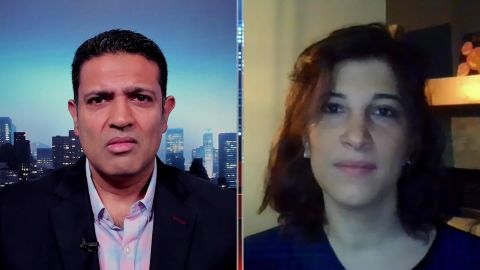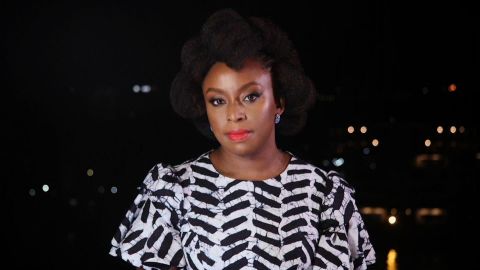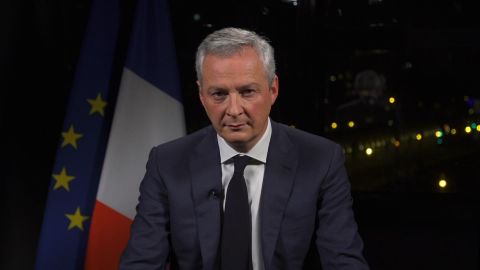Read Transcript EXPAND
CHRISTIANE AMANPOUR: And now, conspiracy and misinformation about COVID and the U.S. election result are spreading like wildfire online. It’s something our next guest has been studying for years. Renee DiResta is a disinformation expert and technical research manager at the Stanford Internet Observatory. And here she is speaking to our Hari Sreenivasan about the dangers of viral false narratives and what she thinks can be done to break this cycle.
HARI SREENIVASAN: Christiane, thanks. Renee DiResta, thanks for joining us. We seem to be in a place where there is an active information campaign to delegitimize the results of the election.
RENEE DIRESTA, RESEARCH MANAGER, STANFORD INTERNET OBSERVATORY: I would say that’s true. I think, beginning on election night, as results began to come in, what we started to see was communities that felt like that the results weren’t coming in the way they would like. And they began to look back to conspiratorial claims that had been laid almost two months prior. Allegations of fraud, the allegations of ballot destruction, miscounting, a whole range of theories began to pop up, particularly in echo chambers like the app Parlor, some Facebook groups, Twitter communities and it began to spread across the internet as the results began to not be a wild victory for President Trump.
SREENIVASAN: What do we do when some of that misinformation, well, and disinformation, ends up being amplified by sources that we normally trust, say, the president or his family or members of his campaign?
DIRESTA: I think that’s one of the key challenges right now, is that the mis and disinformation is not coming from just the few response of the internet, it is coming from what my team at Election Integrity Partnership calls blue check misinformation in response. So, the kind of verified accounts that are on social media. Normally, those accounts, you know, particularly politicians like the president of the United States are people that we trust. And one of the real challenges is we have an environment entirely independent of the internet where half the population trusts only what they see within their media. You know, their half trusts what they see in their media. And so, that kind of bifurcation of trust means that if your person isn’t telling you what you want — you know, if your person is telling you something, it doesn’t matter if the other person’s media or the other person’s leaders are telling them something completely different. So, you have a very divided country that doesn’t have kind of a common sense of facts at this point.
SREENIVASAN: So, how do we break out of that cycle? Because it seems like the technology companies are not necessarily interested in allowing you to leave their ecosystem and go somewhere else for news, because they want to keep you as long as possible. And if you’ve created this filter bubble for yourself, you’re going to stay there.
DIRESTA: That’s true. And it’s even — we’re seeing it even more in the introduction of smaller apps into the ecosystem. So, you know, entities like Parlor, which didn’t exist four years ago, have now become very much an echo chamber for conservatives. And so, as people are moving into these even more kind of niche, insular platforms, they see even less of what people outside of their bubbles are telling them. I think one of the key challenges, though, is that, you know, even within a bespoke reality or an environment where you have kind of the media or leadership ecosystem that’s telling you one thing, usually, in a case like this, in a case like a presidential election, there would be at least some people who are beginning to kind of, you know, accept the facts for what they are and begin to communicate that back out. What’s interesting about Parlor is it’s not the entirety of conservative media, it’s really sort of a niche space within it. And so, Fox News, for example, did call states like Arizona quite early for Joe Biden. And so, there’s been this interesting rift where even within kind of the conservative media sphere, there are some entities that are reporting facts and then there are others like Newsmax or OANN that are actually, you know, kind of distinguishing themselves from Fox, using this as an opportunity to grow their audience by actively positioning themselves as, no, no, we’re a real conservative media and we are telling you the truth. And it’s very cynical. It’s actually very opportunist. It’s really — it’s a growth grift, is what it actually is.
SREENIVASAN: Well, and you see leading conservative voices, whether that’s Mark Levin or even Fox business channel’s, Maria Bartiromo, encouraging people to join Parlor because they feel like they’re going to be censored on the major platforms like Twitter or Facebook.
DIRESTA: Well, they say that. But if you recall, back in June of 2020, June/July of 2020, when Twitter began to fact check and to label President Trump’s tweets, there was also an attempt at a kind of mass exodus to Parlor, made with sort of the same claims, that the president was being fact checked, that conservative censorship was imminent. That conservative people were shadow banned based on viewpoint determinations that platforms were making. Now, none of that was true, but you still saw prominent peoples like Senator Rand Paul and Senator Ted Cruz kind of, you know, do a very public post to Twitter, saying that they were going to Parlor, because they were being censored on Twitter. Now, the logic falls down, but they still did it. And interestingly, despite the fact that they did make this declaration that they were going to be headed to Parlor, they didn’t actually leave Twitter. They still use it constantly. And they use it far more frequently than they use Parlor, and that’s because that’s where people are and they’re not actually being censored. But this narrative, aggrievement narrative, it plays well and, you know, there are certain things that, you know, Twitter and Facebook didn’t necessarily — they don’t really explain how the feed works. People believe if you don’t see every post, you know, if your friends don’t see every post that you’ve made, a lot of people believe that they’re being censored in some way as opposed to the fact that the ranked feed simply didn’t push that tweet out to their friends.
SREENIVASAN: One of the metanarratives that is starting to emerge is something called the Color Revolution. Tell us a little bit. What is that?
DIRESTA: So, in late August, there was a claim made by a conservative influencer that a vast Color Revolution was afoot. A Color Revolution historically referred to mass popular uprising against an authoritarian government or semi-authoritarian government. And that referred to, you know, in Ukraine, the Orange Revolution. There were people, students who marched in the streets carrying signs, wearing orange flags. Those revolutions happened and the governments that were impacted, negatively impacted by them and also kind of power players in the region began to use the term Color Revolution to disparagingly to refer to CIA- instituted regime change, to claim that the revolutions, rather than being actual popular uprisings were really created by the American CIA. So, it’s just a narrative that Russia and China both began to use the term Color Revolution in the context of, for example, the Hong Kong protests and other mass popular uprisings that weakened them, and so they blamed the United States kind of deep state for them. So, the narrative that emerged two months ago that that was happening in the United States. That the American deep state, our own CIA was acting against our own president and this was a kind of vast secret coup. And since Color Revolutions are marked by ballot irregularities and in the streets protests, the Black Lives Matter protests were sort of recast, reframed as a vast Soros-funded Color Revolution, which is untrue. And the — any voter irregularities that would come about from mail-in ballots, you may have recalled, you know, people have been voting for a couple of months. Some of the early vote casting or examples of a postal worker finding a ballot in a — you know, these images of ballots in garbage cans and things like that were kind of recast of evidence of this vast coup that was underway.
SREENIVASAN: It almost seems like this is sort of the grand unified theory. That everything else can fit right in.
DIRESTA: So, that was what we were seeing, exactly. So, it lays the groundwork to be a unified theory in which when a person sees a story of a ballot irregularity in the streets action, they could read into that more than there was. So, instead of it being an isolated example of a voting machine not working, all of a sudden that became part of the conspiracy. If there was an in the streets action because of a, you know, police-involved incident, then there would be, again, a protest, and that would be read as part of the destabilization of America, which was secretly being coordinated by these vast forces. What wound up happening, interestingly, was that the Color Revolution narrative wasn’t really the one that stuck. Certain people did, on election night, begin to point to it, see, this is coming true. They’ve told us about it for two months and now, here it is happening. But the kind of delegitimization that was where they were laying the ground work for that for two months actually really took the form of a hashtag called stop the steal, which is very much simpler than explaining — yes, the complexity of explaining a Color Revolution. But the — that narrative of stop the steal was very, very basic. It was just, the election is being stolen. So, more sophisticated conspiratorial insiders and influencers who had followed this narrative of the Color Revolution, which did make it to Tucker Carlson, did kind of point back to that. But more generally, it was actually the narrative about sharpie markers, Sharpiegate, as it came to be called, as the thing that really stuck and Sharpiegate has been woven into this overarching hashtag, stop the steal, which has led to kind of the spawning of Facebook groups and hashtags on Parlor and hashtags on Twitter and videos on YouTube. And so, under the stop the steal kind of framing, you can find activism insinuating that the election has been stolen across any platform surface that you go look at.
SREENIVASAN: And Sharpiegate is where the theory goes that if you used a sharpie, your ballot was disqualified.
DIRESTA: That’s right, yes. And we have seen local news, particularly in Arizona, really do remarkable work trying to put out the facts with state election officials, with national election officials, in some cases, DHS’s CISA, so reiterating that the election was actually quite smoothly executed. This was not an election where things went badly. And so, the local news, you know, generally occupies a position of trust. And so, they’re trying to put out info graphics detailing, you know, your vote was not invalidated if you used a sharpie. A sharpie is perfectly fine. And trying to walk people through the logic and the facts of that particular voting machine and how it works. The corrections are not always received and believed. Oftentimes, you see people kind of fighting under the posts on a local page saying, no, you’re lying, no, you’re bought. And so, even when local news tries to correct the record on something like Sharpiegate to say, no, this is just not a real thing, people don’t necessarily internalize that.
SREENIVASAN: So, how do we — what do we do about this? I mean, you’ve got YouTube videos that, you know, are algorithmically surfaced. You’ve got actual broadcast, places like Newsmax or OANN that are amplifying these signals. How — is there anything that can be done about it?
DIRESTA: Well, I don’t think it’s — we can’t treat it as an information environment problem. Like, there are certain things that have been very, very wrong for the last five year with regard to ways in which platform recommendations have kind of pushed people into these communities. But, I think, ultimately, the challenge that we face as a country particularly moving forward is bigger than the information environment that’s heavily restore trust so that the echo chambers don’t have quite so strong a hold. And that is a function of what we see and do in the real world and — or the internet is the real world, too. The offline real world.
SREENIVASAN: Yes, yes.
DIRESTA: Where we’re actually communicating with people who aren’t necessarily just like us. We’re hearing alternative points of view and redeveloping trust in media and authority.
SREENIVASAN: Even if the president doesn’t officially concede or he leaves and he never officially says “I lost,” there’s still millions of his supporters who will not believe in the presidency of Joe Biden. What does that do to the country?
DIRESTA: That’s true and that’s the real risk of misinformation that’s going now. Per your point, you know, we do have legal frameworks in place to ensure that there is a transfer of power. We expect those to work. But at the same time, the delegitimization of the next presidency does mean that there are going to be residual people, probably quite many of them, who sincerely believe that the election is illegitimate. So, this is where other people who occupy positions of trust in that community have to come out and have to throw their support behind President Biden. And that, I think is — you know, that is going to extend to media in the trusted environments, as well. I think there will kind of continue to be these pockets, these, you know, kind of grifter media sites like Newsmax and others that are using this opportunity to try to grow their base by, you know, kind of picking off some audience from Fox News. But ultimately, what we’re going to have to see, if we’re going to kind of come forward and, you know, come together and move forward as a country, you know, are these other influencers who occupy positions of trust, beginning to do the work to explain to people that, in fact, President Trump was not re-elected and, you know, President-Elect Biden is where we’re headed.
SREENIVASAN: We’re coming into an era now where there’s going to be a lot of discussions about vaccines. And which vaccine is safe, and whether you should get the vaccine or not. And well before this election, before several elections, there’s been a fairly active anti-vaccine movement online. Are you concerned about kind of the conspiracy theories, the information ecosystem around vaccines, especially when the COVID-19 vaccines come out?
DIRESTA: Yes, absolutely. So, the anti-vaccine movement has been very active on social media for years, upwards of about six years now. Remarkably, politically active as well. Again, this is an example of one of this kind of legacy problems that the early days of mask recommendation, of sensational and conspiratorial content helped grew those communities into the multi hundred-thousand person or groups that exist online today. Those groups have always been politically active. You know, vaccines are a political issue, even things like just state immunization requirements. So, they know how to activate quite quickly. And they are quite well networked with things like the reopen community, the various groups that have been quite active in pushing for states to reopen sooner, and there is a very low degree of trust in government. So, we have seen harassment of public health officials. We’ve seen, you know, of course, attacks, massive attacks on anybody who’s working on vaccinations. There is a lot of concern about what is going to happen both to the people who become, you know, advocates for the vaccine and also the extent to which misinformation about it will prevent people from taking it. Vaccines really work when they create — when there’s a sufficiently large number of people who take them so that the disease can’t hop to those who have not taken them. And that is why we try to ensure that vaccination coverage for childhood vaccines, you know, is above 85 percent in most cases. I think we’re at a point now where, you know, 40 or something percent of the population is saying that they’re not going to get the COVID vaccine. And so, that’s going to be a significant challenge going forward.
SREENIVASAN: Renee DiResta, thanks so much for joining us.
DIRESTA: Thank you for having me.
About This Episode EXPAND
Christiane speaks with French Minister of the Economy and Finance Bruno Le Maire about the anniversary of the Paris terrorist attacks. She also speaks with novelist Chimamanda Ngozi Adichie. Hari Sreenivasan speaks with Renee DiResta, technical research manager at the Stanford Internet Observatory, about the dangers of false narratives on the internet.
LEARN MORE


